Guide to outdoor lighting
Guide to outdoor lighting
Introduction
Outdoor lighting is useful for all sorts of situations. It lights up entrances and walkways, deters would-be intruders and adds ambience to an outside space.
This guide tells you everything you need to know about outdoor lighting. It covers how outdoor lights work and the different types. It talks through the features to look for when choosing exterior lighting and explains IP ratings. It also gives installation information and highlights some things to consider before buying.

How do Outdoor Lights Work?
Outdoor lighting uses power from a mains electricity supply, a battery or solar power to illuminate a bulb. The light can be controlled in several ways:
- Light switch
Like indoor lighting, exterior lighting can be turned on and off from a light switch. Although the light is outside, it can be more convenient to install the switch indoors. Outdoor switches are available for controlling lighting externally.
- Timer
Connecting an exterior light to a timer allows it to be turned off automatically after a predetermined length of time. This can be useful for lights in areas that only need to be illuminated for a short period, such as a porch.
- Motion sensor
Functional exterior lighting (e.g., security or walkway lighting) is often fitted with motion sensors designed to work once it gets dark. The light switches on when the sensor is activated and then turns off after a predetermined length of time. This ensures energy is used efficiently as the light is only on when needed. The best outdoor motion sensor lights use PIR (passive infrared) sensors. These sensors are more accurate than other types because they detect body heat, not just movement.
- Smart device
Smart outdoor lighting has an inbuilt device that allows it to be connected to the internet via Wi-Fi. The light can then be controlled by an app on a smartphone or tablet or by voice command through a smart speaker. It can be controlled remotely or scheduled to turn off and on automatically, adding additional security when away from home. Read our smart lighting guide for more detail.
-
Solar powered
Solar outdoor lights use a photocell or photoresistor to control the circuit inside the solar light depending on how dark or light it is. This technology has a dusk-to-dawn sensor, and they will turn on at night, when it detects little or no light, and off during daylight hours as the solar panel charges the battery and photoresistor stops the lights turning on.
Types of Outdoor Lighting
Outdoor lighting comes in various types and styles, each suitable for different purposes.
Here, we look at the most common types of exterior lighting, their benefits, and where you might use them.
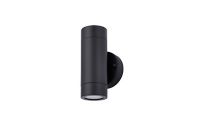
- Outdoor wall lights
Wall lights are available in both contemporary and traditional designs and are ideal for lighting pathways, seating areas or patios outside. Great for style and ambience, but also practical for security. Some outdoor wall lights include a passive infrared sensor (PIR) to illuminate only when motion is detected in the area which is a great way to save energy, and others are mains, solar or battery powered.
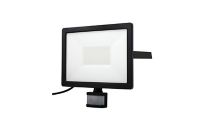
- Floodlights
Floodlights give out a bright, intense flood of light, making them ideal for illuminating large outdoor spaces that need to be well lit. They're also popular for security purposes and are often installed above entrances, in driveways or along walkways. In addition, they have LED lights that are energy-efficient to run, reducing their carbon footprint and saving money on energy bills.
Floodlights are available in various styles and have different wattage options to choose from based on how bright the light needs to be and the size of the space being li
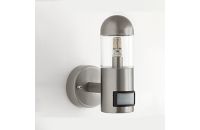
- Security lights
Security lights are the perfect deterrent for intruders. They illuminate dark paths or entrances, leaving nowhere for the intruder to hide. The best security lights are activated by motion or PIR sensors, which trigger the light to come on when heat is detected. This, combined with low-energy LED bulbs, helps reduce energy consumption as the light is only on when needed.
Security lights come in various designs, from functional-looking wall and ceiling lights to decorative wall lights.
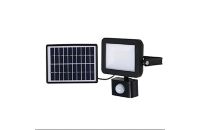
- Solar garden lights
Solar garden lights have photovoltaic cells on their exterior that absorb energy from sunlight and convert it into power that's stored in a battery. This is then used to power the light in the evening. Solar lights are easy to install because there are no wires, and they don't cost anything to run.
Choosing the best outdoor solar lights for your needs depends on where they need to go. Most have photovoltaic cells on the body of the light, so they'll need to be placed in an area that gets plenty of sunlight. But, if you want to install a solar light in a shaded area, versions are available that have photovoltaic cells on a separate panel that's joined to the light with a wire. So, the light can be installed in the shade, and the panel can be installed in a sunnier place.
Solar garden lights come in many styles, such as wall-mounted lanterns with PIRs, motion sensor bollards for security, and colour changing table lamps for warmth and ambience.

- Decking lights
Decking lights are small, round lights recessed into decking for a sleek finish with no trip hazards. They're the perfect way to add ambience to an outdoor space and make decking safe in the dark because the lights illuminate the decks' edge and steps. In addition, they have LED lights that are energy-efficient to run, reducing their carbon footprint and saving money on energy bills.
Decking lights are available in several styles and are mains-powered. Some are sold singularly, but most come in packs of 10 or more.
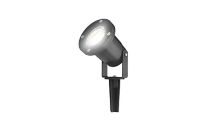
- Garden spike light
Garden spike lights are low-level lights with a spiked pole mount that's inserted into the ground. They are often designed as spotlights with adjustable beams, making them the best outdoor garden lights for highlighting features, such as flowerbeds, trees or water sculptures. They’re also perfect for lighting up pathways. Most garden spike lights have energy-efficient LED bulbs.
Garden spike lights are available in several styles and are mains-powered. Most are sold singularly, but some come in packs of 4 or more.
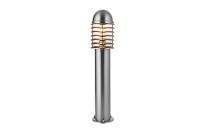
- Garden lamp posts
Garden lamp posts, also known as post lights or bollards, have become popular for gardens. They offer a decorative feature as well as a practical solution to lighting patios and driveways. Outdoor post lights are typically taller than other alternatives, ensuring good light coverage without being too bright. Many, but not all, use energy-efficient LED bulbs.
Garden lamp posts come in various traditional and contemporary styles and can be mains, solar or battery powered.
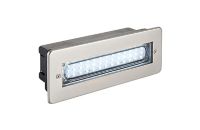
- Brick lights
Brick lights are rectangular lights recessed into walls at a low level. They were originally designed to replace a single brick in a wall but are now available in various sizes. Brick lights are perfect for use in walls that run alongside paths or driveways. And they can be used as an attractive addition around a seating area.
Brick lights come in various styles and sizes and are usually mains powered.
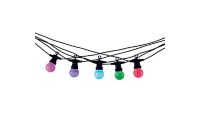
- Other outdoor lights
The exterior lights above are the most popular types, but a few others are worth mentioning.
For example, coastal lighting is made from marine-grade stainless steel, which makes it ideal for homes exposed to the harsh salty winds of coastal areas.
Festoon lights are chain or string lights that are suitable for different uses. For example, some are designed to light up walkways on construction sites, while decorative string lights with multi-coloured bulbs can be used to create a party atmosphere in a garden.
And ground lights are recessed into the ground to safely illuminate paths, seating areas, and steps. They make one of the best outdoor patio lights because they can even be recessed into paving slabs and concrete.
Choosing Outdoor Lighting
Once you’ve decided what type of exterior lighting you need, there are a few more options to consider:
Colour of outdoor lighting
All outdoor lighting comes in a casing which can be one of several colours, including black, white, steel, grey, silver, or blue. This choice allows you to choose a colour that suits the style of the house and garden. You can even match the colour to other features, such as window frames, garden furniture, or garden ornaments.
Sensor types explained
Sensors are electronic devices that are built into some outdoor lights. They detect movement, light, or heat and use that as a trigger to turn the light on and off. There are several types of sensors available:
- PIR (passive infrared) sensors detect heat energy which triggers lights coming on when a person approaches. Detecting heat rather than movement makes PIR sensors more reliable than other types because they will only be activated when they detect people, not debris blowing in the wind.
- Photocell sensors detect ambient light levels and are used to automatically turn lights on and off at dusk and dawn. They automatically adjust to seasonal changes and are unaffected by the clocks going forward or back.
- Microwave sensors push out a high-frequency radio wave to detect movement. They are effective in large areas but are very sensitive compared to other sensors. This makes them unsuitable for use in open spaces or around homes as they can be triggered by blowing leaves or other small objects.
- PIR and photocell sensors are often combined in exterior lighting. The photocell sensor ensures the light only comes on when it's dark. And the PIR sensor is used to detect heat to trigger the light.
Power sources explained
Exterior lighting can use one of three different power sources:
- Mains electricity is the most reliable power source. The lights burn consistently and brightly for as long as you need them, which is beneficial for areas where it would be inconvenient for them to fail. The only drawback to mains-powered lighting is that the wires make installation more complex, and if new cabling is required, they must be installed by a qualified electrician.
- Solar-powered lights use energy from sunlight to light the bulb. They don't need wiring, so they are easy to install and don't cost anything to run. They won't burn as brightly or for as long as mains-powered lights, but improvements in technology mean they are more powerful and last longer than they used to. So they are ideal to use in areas where you want to create ambient lighting rather than where you need bright light. Or where only short bursts of light are required, such as on security lights with PIR sensors. But they need to be placed in sunny spots to ensure the battery gets a full charge each day.
- Battery-powered outdoor lights emit a constant amount of light until the battery runs out, in which case the battery can be replaced. The frequency of battery changes will depend on how big the light is and how often it's used. This can become costly, so battery-powered lights are best used for small, infrequent lighting, such as security lights with PIR sensors and lights that use energy-efficient LED bulbs. Like solar lights, battery-powered lights have no wires, so they are straightforward to install. But remember to consider how easy it will be to change the battery depending on the location of the light.
Colour temperatures explained
All light bulbs produce slightly different colours, referred to as colour temperatures. Those colours are measured on the Kelvin (K) scale, and they are given a correlated colour temperature (CCT) name. The Kelvin scale ranges from warm, soft, yellowy hues (2700K) to cool, bright, crisp whites (approx. 6500K). The higher the Kelvin number, the whiter the light will be.
For exterior lighting, opt for bulbs with a max CCT of 3,000K or lower, described as warm, very warm or extra-warm white light. Also, check the lumen level, which indicates how bright they are. Ideally, opt for a low lumen level (unless it's a floodlight or security light), so the lights aren't too bright.
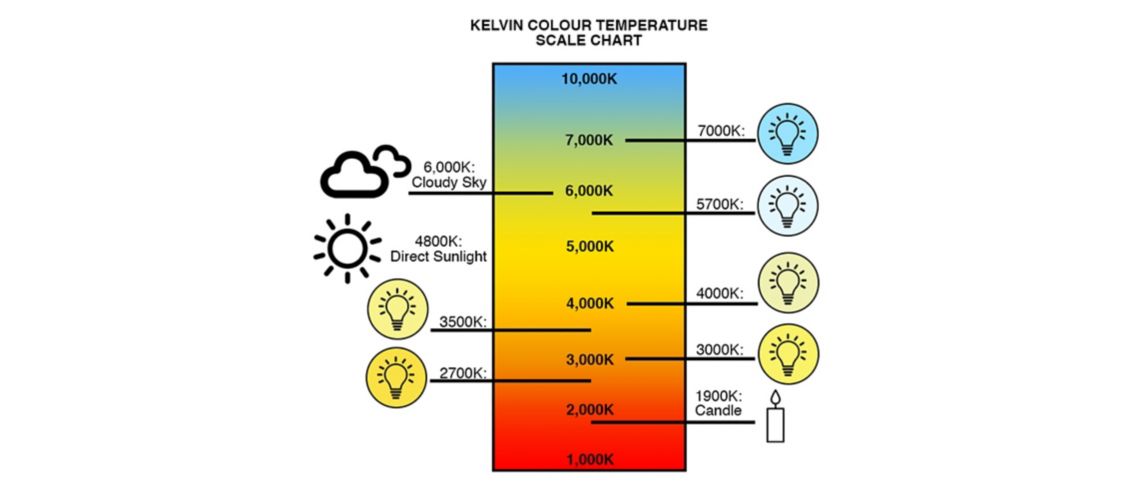
Outdoor Lighting and IP Ratings
To avoid the dangers of mixing electricity with water and dust particles, all outdoor lighting must meet certain requirements set out by BS and CE standards. So, they are given an IP (ingress protection) rating.
The IP rating refers to how much protection the light gets from its casing, and it's shown using the letters IP, followed by two numbers. The first number refers to how resistant the casing is to dust, and the second number refers to how water resistant the casing is.
Exterior lighting must have a higher IP rating than indoor lighting because it’s exposed to the elements. As a minimum, it must be at least IP23. But, to decide what IP rating for outdoor lights is best for your needs, think about where the light will be placed. How exposed to the elements will it be? Will a hose be used near it? Is the home in an area with a lot of dust or sand?
As a guide, select an IP43 rated light to go under a roof, IP44 for a light exposed to light rain, IP65 for a light exposed to heavy rain and IP68 for a light that will be submerged in water.
How to Install Outdoor Lighting
Installation of battery or solar-powered outdoor lighting is usually a simple job that can be carried out by a DIYer. There are no wires to worry about, and they aren’t connected to the electricity supply. So, the job only involves fixing them into their position.
Wireless garden spike lights are the easiest to install because they are simply inserted into the ground, which can be done in a few minutes.
Wireless wall lights are harder to install as they must be attached to a brick wall. It involves marking out the position for screw holes using the backplate supplied with the light as a template. Then, drilling the holes using a hammer drill, inserting wall plugs, and screwing the backplate to the wall. Once the backplate is in place, the wall light can be attached. This job may take around 30-60 minutes for an experienced DIYer.
Wireless bollard lights are installed in a similar way to wall lights, except they are fixed to the ground instead of a wall.
Installation of mains-powered exterior lighting is more complex because it involves running electrical cables through walls or under the ground and connecting them to the mains electricity circuit. Depending on the type of light, it may also include installing new switches. In addition, there are a lot of safety procedures involved in this type of installation. Such as burying cables at the correct depth to ensure they don't get accidentally cut and ensuring all parts of the circuit outside or where it enters the house are weatherproof. So, this is a job that's best left to a qualified electrician.
What to Consider When Buying Outdoor Lighting
We’ve covered the most essential information about outdoor lighting above, but here are a few more things to consider before you buy:
-
What do you need the lighting for?
Before deciding what type of exterior lighting to buy, think about what it will be used for. For example, to add ambience to a garden, choose low-level lights with a soft glow that's not too bright. If it's for security, choose a PIR security light with a bright light. -
Where do you want to light?
It's important to position lights so they light up their chosen area appropriately. For example, if you want to highlight features in a garden, use stake lights and position them close to the object you want to highlight, with the beam pointed at it. If you need to light up a large area, use a floodlight which should be positioned high above head height to avoid glare. If you are lighting a path, ensure the light spans the whole of it and not just one part of it. You may need to use multiple lights here. -
What power source is best?
Choosing a power source for exterior lighting is often down to how bright or reliable the lights need to be and how close they will be to the house. Mains-powered is ideal if the light will be attached to or close to a house. It's also the most reliable source as the lights will burn consistently and brightly for as long as you need them. The downside is that it's not easy to move them once they are fixed in place. So, if lights need to be portable, solar or battery-powered is best as there are no wires to worry about. Solar and battery-powered lights are also easier to install, but they won't be as bright or last as long as mains-powered lights. -
Light bulbs for outdoor lights
Most outdoor lighting comes with or uses LED bulbs. They are the most energy-efficient bulbs available (using up to 90% less energy than traditional incandescent bulbs). They're quick to light up, don't get too hot, and last between 25 and 30 years. Also available are halogen bulbs, which are less energy-efficient than LED (using 20% less energy than incandescent bulbs). They get hot when used for extended periods and last less than two years.
As well as considering types of bulbs, look at how bright they are. Brightness is measured in lumens (not wattage). A low lumen level is best for most exterior lighting, so they aren’t blindingly bright. But when it comes to security or floodlights, a high lumen level is best.
